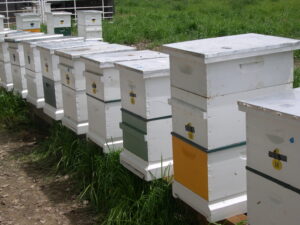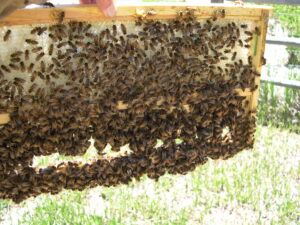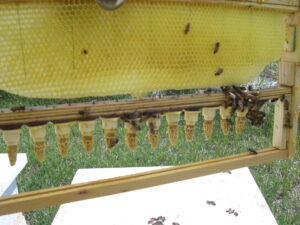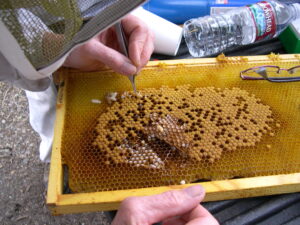Final Report for FW14-027
Project Information
The CO Queen Honey Bee Testing Project for Increased Sustainability was aimed at reducing or eliminating the dependence of chemical treatments on honey bee colonies to control the number one pest to honey bees, the varroa mite. Instead of relying on commercially available chemical treatments, we hoped to identify superior honey bee stock that would show increased resistance to the varroa mite as well as brood diseases, through their own genetic traits.
114 honey bee packages were installed in our three Colorado producers apiaries. Test queens were selected from 5 different commercial producers propagating the most genetically varroa resistant stock available to US beekeepers in 2014.
Testing and data collection of surviving colonies was started in May of 2015. Breeder candidates that scored the highest with our battery of tests were identified and used for additional propagation within each producer’s apiary. Additional virgin queens were also reared by our producers and distributed to CO beekeepers interested in participating in our project the end of June 2015.
Unfortunately, during our first winter of 2014-2015, two of our producers suffered substantial colony losses. With limited data, and limited colony resistance to the varroa mites, both producers participation in the project came to an end in the fall of 2015.
Our principal investigator continued the project over the winter of 2015-2016. Overwintering strengths, splits, honey production and additional propagation was completed throughout the 2016 summer season. Unfortunately, by the fall of 2016 all remaining project colonies within the Ft. Collins apiary were also showing extensive varroa mite populations and were treated with a newly registered organic treatment, oxalic acid vapor.
While we had great hopes and expectations for this project, it has continued to be extremely difficult to maintain honey bee colonies within the CO region without a proactive varroa mite control program… Thus, our ultimate project goal of producing a totally treatment free genetically resistant honey bee stock for Colorado beekeepers was not successful.
Introduction
Our project began with the installation of 114 3lb. honey bee packages from Strachan Apiaries in April 2014. Throughout the summer each of our three producers installed and or propagated 36 honey bee queens from Olympic Wilderness Apiaries, Old Sol Apiaries, Harbo Bee Company, VP Queens and, in 2016, Kirk Webster. These select producers promote queen stock with reportedly superior genetic resistance to the number one honey bee pest, the varroa mite.
Each producer also reared virgin queens for distribution at the CO State Beekeepers Association Summer meeting in June, 2014. Any CO beekeeper interested in participating in our project received up to two virgin queens to test in their own apiaries.
However, the summer of 2014 proved challenging throughout the CO regions due to drought conditions and feeding all colonies carbohydrates and or pollen substitute to promote brood rearing and wax production was necessary.
The goal of the first season was the installation, propagation, and feeding of all the test colonies to build to wintering strength in both cluster size and honey stores.
A late spring in 2015 hampered spring build up for all our colonies. However, we were able to begin testing and data collection with our battery of tests by the end of May, 2015. The overwintered surviving colonies were tested for their hygienic behavior; the percentage of fertile to infertile varroa mites in the brood comb; as well as the percentage of varroa mites per colony. All three producers were involved in the testing.
Once the strongest colonies within each apiary were identified, propagation was begun. Grafting, cell building and making up mating nucleus colonies was undertaken in each producer’s apiary.
Additional distribution of virgin queens to interested CO beekeepers continued as an important part of this project and was done for the second year in June, 2015. Up to two virgin queens were distributed to CO beekeeper. These were to remain untreated and success or failures recorded each year.
We presented a summary of our project and findings at our Western Apicultural Society’s annual conference in Oct. 2015. Graphs and results of our 2 year testing project gave conference attendees valuable feedback on these tested sources.
Our two producers in Walsenburg and Longmont concluded their participation in our project after two years. Any of their surviving colonies would provide potential breeding stock within their selected regions.
The Ft. Collins apiary was prepped for 2015-2016 winter conditions and would provide another year of additional data. One additional queen stock that was intended in our first introductions of the project was not available until spring of 2016. That stock was introduced during June 2016 and preliminary results indicate some success.
Our three CO producers were selected from 3 different regions with 3 different levels of experience and expertise. The principal investigator, Kris Holthaus with the Ft. Collins apiary, has been a beekeeper since 1978 and has specialized in Queen Rearing survivor stock since 2001.
Dean Chapla from the Longmont area has commercial beekeeping experience, growing up in CA and participating in the pollination needs of his family’s orchards. He was selected for his ability to address the commercial beekeepers’ challenges and needs for increased resistance to the varroa mite. His queen rearing techniques stemmed from a commercial background where quantities of queen cells/queens were produced.
Our southernmost producer, Janet Fink from Walsenburg, has been very active in her region’s education, development and procurement of quality bees and queen stock. As a member of a previous grant study, The Rocky Mountain Survivor Queen Bee Project, she has been gaining valuable experience in queen rearing. (Year 1)
We issued a preliminary survey to CO State Beekeepers that showed the greatest area of concern in their apiaries was the varroa mite. Two other areas that CO beekeepers were interested in improving were colony honey production and temperament. (Year 1)
Based upon this input, 5 sources of queen stock was selected and installed. These sources included: Old Sol Apiary and Olympic Wilderness Apiary with 3 lines. The two additional lines were incorporated by the producers themselves with the use of Instrumentally Inseminated Varroa Sensitive Hygienic (VSH) Breeder Queens provided by John Harbo of Harbo Bees and VP Queens. Each producer then reared their own regional queen stock mated with their locally adapted drone stock to become part of our project. (Year 1)
This breeder stock and the associated virgins were also used for interested CO beekeepers wanting to participate in the project in both 2014 and 2015. Each producer provided up to two virgins to each area participant the end of June 2014 & June 2015. These virgins were then mated within the participants’ localized region and remained untreated. (Year 1-2)
Our website: https://coloradoqueenhoneybeetestingproject.wordpress.com was developed and maintained to show our progress on the project. Data, links, research, results and the producer’s apiaries were all listed to provide input on our CO state project. (Year 1-2)
Testing protocols and procedures were developed and readied for spring 2015. (Year 1)
All three producers gathered for testing overwintered colonies that consisted of greater than 2-3 frames of bees the end of May, 2015 (Year 2)
A complete battery of tests was completed. (Year 2)
- Natural 24 hr. varroa mite drop count
- 24 hour hygienic behavior liquid nitrogen test
- Ratio of fertile to in-fertile varroa mite count
- Uncapping/Capping percentages
- Colony size
- Temperament of the colony
Upon completion of these tests, selections were made for propagation and distribution. Grafting, cell building and additional mating nucleus colonies were made up in each producer’s apiary. (Year 2)
The colonies then began their roles as production colonies in each apiary. Total production was also recorded. (Year 2)
Presentations at our Western Apicultural Society Conference took place in Oct. 2015. Results of our tests and internet links to our project sources were included for all attendees. (Year 2)
Presentations by our producers to their local and regional Beekeeping Clubs also took place throughout the two years of our project. (Year 1-2)
We would like to develop a CO Queen Rearing Cooperative where our producers will be able to work with others in their regions by sharing their knowledge, stock, and suggestions on how to continue to increase genetic resistance to the varroa mite. (Future)
Cooperators
Research
|
|
All our package colonies were installed in Langstroth 8 or 10 frame deep hive bodies and identified with a number 1-36. We used screened bottom boards to assist with our natural varroa mite drop counts. All packages were started with 7-9 frames of foundation and 1 drawn frame. Syrup was fed in both internal frame feeders and/or glass jars above the inner covers. |
Our test queens were installed into each producer’s numbered colonies. 6 of the original queens in our packages remained with their colony and were used as the control group in our project. The commercial source of our test queens was unknown to our producers until testing was completed in May, 2015.
Queen rearing by the producers with their Instrumentally Inseminated Breeder Queens was done with Doolittle’s grafting method. This involves transferring 12-24 hour larva into a queen-less cell builder. Mating nucleus colonies were made up with either queen cells or emerged virgins. Once the virgins were mated, they were transferred to the designated colony where they would remain throughout the project. The quantities and qualities of the queen rearing conditions were dependent on each individual producer’s experience, location, and available resources.
|
A well populated cell builder |
Nice uniform queen cells |
Test Queens placement was done by drawing numbers randomly.
Key to Chart below: Original Strachan Package Carniolan Queen= Control-C
Harbo Bee Co.-H Old Sol Apiaries-OS Olympic Wilderness provided two lines: Russian-R
Suppressed Mite Resistance-SMR VP Queens-VP
1 OS 2 H 3 VP 4 SMR 5 C 6 OS 7 C 8 H 9 OS 10 H
11 OS 12 C 13 H 14 H 15 H 16 VP 17 VP 18 C 19 VP 20 VP
21 R 22 H 23 SMR 24 R 25 H 26 H 27 C 28 OS 29 C 30 H
31 VP 32 VP 33 SMR 34 VP 35 R 36 OS
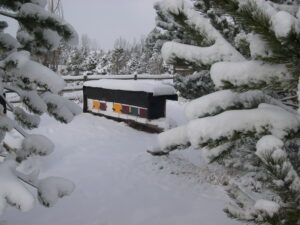 |
Winter preparation of 2014-2015 was left to each producer’s discretion. Colonies in the Ft. Collins apiary were insulated, packed together and left undisturbed until April. |
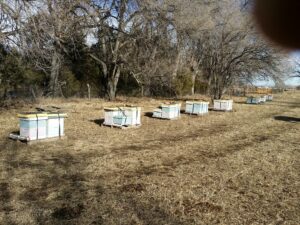 |
Colonies in the Longmont producer’s apiary were insulated above their top covers and maintained throughout the winter on 4 way pallets. |
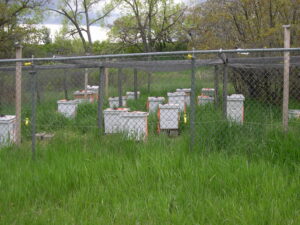 |
Colonies in the Walsenburg apiary spent the winter enclosed in bear fencing and strapped down for winter weather. |
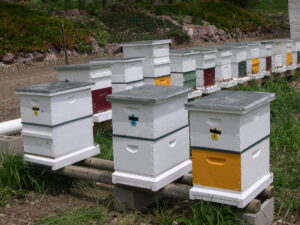 |
Testing procedures began in May, 2015 at the Ft. Collins apiary. All colonies were first inspected for colony size and temperament. All test queens were located, identified, and placed below a queen excluder for safety. Brood frames containing the appropriate age pupa to be used in the Varroa mite test, (purple eyed and older) and the Hygienic Behavior test (white/pink) were identified, marked and placed above the queen excluder to be retrieved for testing. |
Natural 24 hour varroa mite drop counts were made by pulling the slides on the screened bottom boards and counting mites.
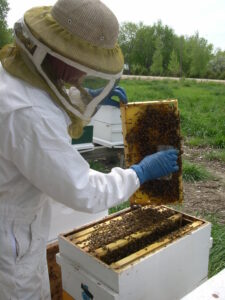 |
Alcohol washes were done with a sample of 300 bees taken from open brood frames. We also tested a Powdered Sugar Shake with the same 300 bee sample to avoid killing the bees but found that the count was very inaccurate. For example; powdered sugar shake with 300 bees found 4 varroa mites. Using 300 bees from the same frame with the alcohol wash, we found 16 varroa mites. With this discovery, we used the alcohol wash thereafter for our data collection. |
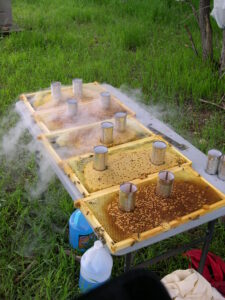 |
We used Liquid nitrogen for our Hygienic Brood Behavior test. Two 8 oz. cans were used to isolate the freezing of brood in two different areas of a compact brood frame containing white/pink pupa. The percentage of brood removed after 24 hours gave us a good indication of the Hygienic qualities within the particular colony. *Note: if we had used older pupa, tan or ready to emerge, it would have been difficult to be sure that the more mature pupa has been frozen. Consequently it might not be removed by the colony thereby adversely affecting our counts. The selection of younger pupa assured us that they would be affected/frozen by the liquid nitrogen. |
|
|
The Fertile-Infertile varroa mite test consisted of uncapping and pulling out 100 purple eyed and older pupa shown in the top left photo. This ensures the greatest length of time in the capped cell for the varroa mite to reproduce. If only the foundress mite was discovered that would indicate an infertile mite. If a foundress mite, together with male, and daughters are all found in a cell, this would indicate a fertile mite family. The infertility of the mite is thought to be caused by the colonies’ pheromone levels although this is still not quite fully understood. While still being evaluated it has been recognized in the field as leading to genetically resistant stock. |
The Uncapping/Capping test, illustrated above in the lower left patch of the brood frame. This is a procedure that removes the wax capping layer over a patch of brood cells equaling approximately 50 cells. The number of cells that have been recapped was observed and recorded. *This test shows the trait or behavior within the colony to remove either a diseased larva and or a larva/pupa with varroa mites. The queen lays in the cell and it is recapped at the appropriate time.
Colony strength was graded on cluster size, how many frames of bees, brood, honey and pollen stores were found. This is very similar to how colonies are graded in CA for Almond Pollination.
Temperament was also a consideration and determined during the time the colonies were being evaluated. Unfortunately both the Ft. Collins apiary and the Longmont apiary had individual colonies that were removed from testing until the end of the day due to aggressive behavior.
The amount of or lack of diseased brood was also noted.
Each yard was similarly tested the last week of May, 2015 with all colonies greater than 2-3 frames of bees.
Once the strongest colonies were identified, each producer commenced additional queen rearing for both their own apiaries and the CO Beekeepers participating in our project.
Virgins were marked and distributed with pick up at the producer’s apiary within 24-48 hours of emergence. All the virgins distributed were to remain untreated for up to two years.
Honey production was based on the number of filled honey supers in the fall of 2015.
As mentioned previously, the first year’s installation of 36 package bees into each of our 3 producer’s apiaries proved quite challenging due to moderate to extreme levels of drought conditions. 36 gallons of syrup were being fed weekly throughout the summer in several locations.
Strachan Apiaries, the source of our packages, proved to be a very good provider of quality bee packages although the industry accepts that they would need to be treated for varroa mites. Our 114 packages did well to get our project started. Once these colonies were installed all but the control queens were removed so our resistant queen stock could be introduced. (There are no treatment free honey bee packages available in the US today).
The sources for our 108 test queens included a number of producers. Old Sol Apiaries provided us with his Premium Select queens for testing which accounted for the top 5% of his stock. His delivery was on time and his queens were easy to install and a very positive company to have within our industry. Unfortunately this stock did not test as well as we had hoped left untreated.
Olympic Wilderness Apiary experienced a cold wet spring in 2014, consequently our queens arrived the beginning of summer. We received both Russians and their SMRs, Suppressed Mite Resistance queens. These queens required a longer introduction period before they were released within the colony. While several of these colonies did test high in both hygienic behavior and cluster size they also proved quite defensive and aggressive. It was left to each producer whether to propagate queens from these defensive colonies. (The Ft. Collins apiary did not, while the Longmont apiary with few survivors did).
John Harbo of Harbo Bee Co. was one of the original identifiers/developers of the SMR bee, or bees with Suppressed Mite Resistance while at the USDA Research Station in Baton Rouge, LA. We felt extremely lucky to be able to get 3 Instrumentally Inseminated Resistant Breeder Queens from him. With the southern climate he was able to provide us with early spring delivery which was very important in getting our test queens reared, installed and distributed in a timely manner. However the producers recorded varying results with their reared test queens based on their region’s drought conditions, their experience in queen rearing, and the quality of the surrounding localized drone stock that were mating with these virgins.
The only negative in our sources for resistant Breeder Queen stock was VP Queens. Unfortunately they are the only other commercial source to offer Instrumentally Inseminated Breeder Queens at an affordable price. Hopefully they will be replaced as a source. All areas of the encounter proved challenging for us and we would not recommend them.
Our last producer was Kirk Webster, known throughout the beekeeping community as a quality supplier of varroa resistant stock. Unfortunately he is a small producer and it took 2 years to receive his stock which was delivered in June, 2016. Initial observations were good build up and well mated queens laying up full frames of brood. These colonies were prepped for winter in the Ft. Collins apiary.
With the winter of 2014-2015 complete we began testing our overwintered surviving colonies in May, 2015.
Below is a data sheet for the Ft. Collins Apiary. 30 out of 36 survived the winter. 22 were tested at the Cobb Lake yard. Additional colonies that were in swarm preparation or had superseeded their original test queen were not tested.
Key to color below: Dark Blue indicates the top colonies in a specific test. An Example: Cluster Size with the greatest number of bees covering a frame. Colony #1, 32 & 13 had the largest populations of bees at the time of the test. Yellow indicates the top honey producers of 2015. Red indicates a failure at production and would be potentially re-queened.
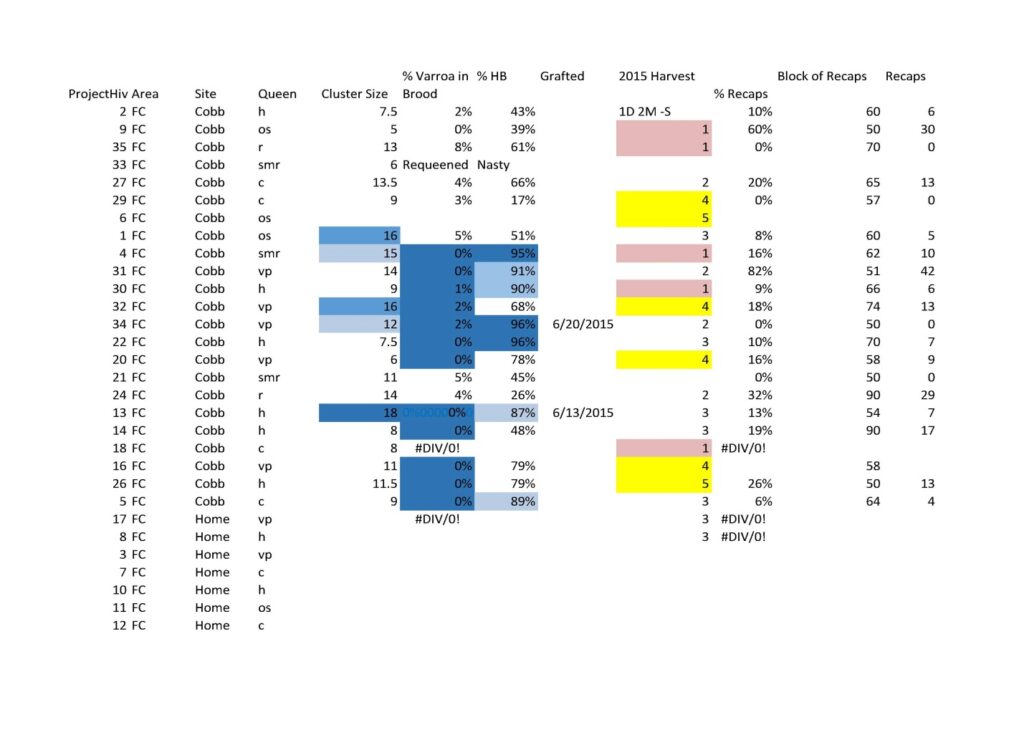 With the above data several colonies were selected for propagation. #13 was specifically chosen for its cluster size (strength) 18 frames and relatively good hygienic behavior at 87% and 0% of varroa mites in the brood. This was a queen that was reared from the Harbo Bee Co. Instrumentally Inseminated Breeder Queen, reared within the Ft. Collins apiary.
With the above data several colonies were selected for propagation. #13 was specifically chosen for its cluster size (strength) 18 frames and relatively good hygienic behavior at 87% and 0% of varroa mites in the brood. This was a queen that was reared from the Harbo Bee Co. Instrumentally Inseminated Breeder Queen, reared within the Ft. Collins apiary.
Additionally #13 was the queen stock distributed to the northern CO beekeepers interested in participating in our project in 2015. Unfortunately the feedback was 50/50 whether the virgins distributed were successful in mating. If they were successful in mating it was again 50/50 if they survived the winter. Very few participants were successful, but those that were have used the stock for their own breeding program which was our intent. However, we had hoped for greater success.
The Longmont apiary did not fare so well coming out of winter. Out of the original 36 colonies at the Nimbus apiary, 11 colonies survived the winter. We were able to test 8 of the surviving colonies with 3 of the colonies too weak to be tested. Parasitic mite syndrome or PMS, caused by increased levels of varroa mites was seen in several of these colonies. However with the influx of warmer weather, natural pollen and nectar becoming available, the colonies recovered.
Note on the data below: No results indicate a dead out.
PMS or Parasitic Mite Syndrome: Brood disease caused by excessive varroa mite population
Color Blue: Indicates a top colony within that particular test. #21 had a cluster size of 20 frames and was in need of being split before the colony swarmed.
#9 had a 0% of varroa mites but was half the size colony of others.
#13 removed the most amount of frozen brood in our Hygienic test.
*This commercial producer has since reared additional queens from #21 focusing on the cluster size and disease resistance. Not shown on this data sheet is the aggressive temperament that this colony possesses. Distribution from this queen stock is made with a warning to beekeepers.
Below is the data sheet for the Nimbus Apiary and the testing results.
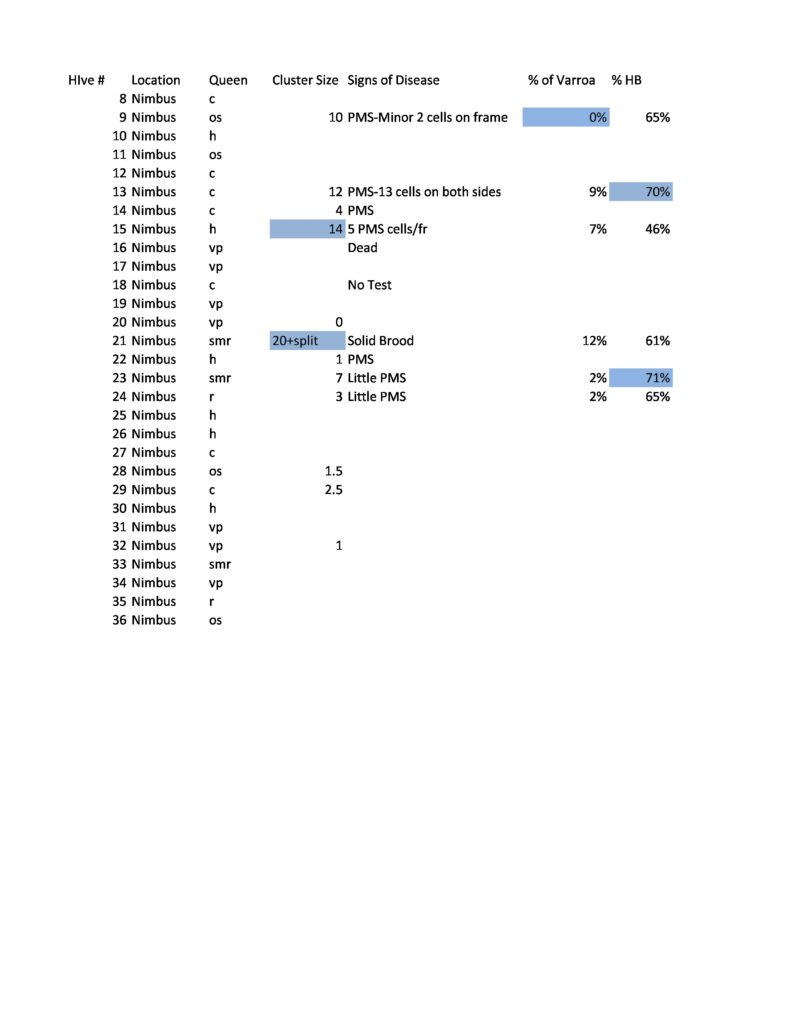
The Walsenburg apiary experienced the greatest challenges within this project due to their multi year drought conditions. Installation of the packages required constant feeding. Queen Rearing with our Instrumentally Inseminated Breeder Queens was also hampered by limited natural resources that included natural pollen and nectar. Consequently more of the existing package or control queens went through winter heading the colonies. Due to this, they were weak if they survived and slow to build up in the spring of 2015. Therefore there was no testing at the Walsenburg apiary.
Distribution to our CO Beekeepers of virgins reared from our top performing colonies was done at the end of June 2015. As previously mentioned, the Ft. Collins apiary distributed virgins from #13 identified above, the Longmont apiary distributed from #21 with a warning on temperament.
Once all our data was recorded and our honey production concluded, we presented our findings at the Western Apicultural Society’s Conference in Boulder in Oct. 2015. Results from our testing, links to continued research, sources of varroa and disease resistant stock were presented to the attendees.
At this time in the fall of 2015, participation in our project by the Longmont and Walsenburg producers came to an end. With their previous winter losses and continued varroa mite pressure it was left to the individual producer whether to treat their remaining colonies or not.
Thus the Ft. Collins apiary prepped for another winter and in the summer of 2016 received an additional line of resistant honey bee stock from Kirk Webster. Our project has been on his wait list for 2 years. These were installed in standard 8 frame Langstroth equipment and have done well throughout the summer of 2016.
Our producers are now better equipped to share our testing procedures with other CO Beekeepers as a result of this project. The growing number of beekeeping clubs in CO have benefited from knowing where they can source bees and queens with potential levels of resistance to varroa mites and additional traits that will lead to less brood disease.
However, after three years of study, testing, and propagation it’s still obvious with these above stated losses that varroa mites still pose a serious threat to CO honey bees if not treated. While we did not suffer 100% losses, 70% loss is not acceptable. While our project centered on non-treatment, it’s untested how the colonies would have fared with a reduced treatment schedule. Because of our significant losses, we would recommend a minimal treatment regimen until there is more resistant genetic development within the industry. Colorado winters still pose significant challenges. Any colony significantly weakened through varroa mite infestation has limited ability to survive.
Research Outcomes
Education and Outreach
Participation Summary:
Our most significant forms of outreach included our many presentations to area beekeeping clubs. Since the approval of our project, we have contacted each regional CO beekeeping club as to our goals and progress and issued invitations to participate through the distribution of resistant virgin queen stock.
We presented our project to the CO State Beekeepers Association members during the summer of 2014 with a virgin queen distribution to those interested in participating. Additional distributions of resistant honey bee stock were done in each producer’s apiary in both 2014 and 2015.
Another significant presentation was made at the annual conference of the Western Apicultural Society in Oct. 2015. All methods, stocks, and results were presented to the attendees. Correspondence by others interested in duplicating our project within their own regions is ongoing.
Our results will continue to be posted on our website: https://coloradoqueenhoneybeetestingproject.wordpress.com/ , and will include any additional findings, results of future propagation by our producers and the results from our last stock undergoing testing within the Ft. Collins apiary through the winter of 2016.
Education and Outreach Outcomes
Potential Contributions
While we were focused on involving CO beekeepers in our project, we have had significant interest by additional US beekeepers facing these same challenges. The results from testing the genetically resistant stock within our project will be valuable to other US beekeepers and those abroad. Whether they are a commercial beekeeper with thousands of colonies or a smaller scale beekeeper with 1-100 colonies, everyone needs to be proactive in this fight. Thus sharing our methods, stocks and results with beekeepers throughout the world may provide a means to control the common winter losses associated with the varroa mite in the future.
Each US region should be able to collectively identify colonies with traits that provide the greatest active resistance to the varroa mite and propagate from those stocks by forming cooperatives. Through propagation, the rearing of quality resistant queens can be done efficiently given good weather and plenty of natural nectar and pollen.
Future Recommendations
Our most significant forms of outreach included our many presentations to area beekeeping clubs. Since the approval of our project, we have contacted each regional CO beekeeping club as to our goals and progress and issued invitations to participate through the distribution of resistant virgin queen stock.
We presented our project to the CO State Beekeepers Association members during the summer of 2014 with a virgin queen distribution to those interested in participating. Additional distributions of resistant honey bee stock were done in each producer’s apiary in both 2014 and 2015.
Another significant presentation was made at the annual conference of the Western Apicultural Society in Oct. 2015. All methods, stocks, and results were presented to the attendees. Correspondence by others interested in duplicating our project within their own regions is ongoing.
Our results will continue to be posted on our website: https://coloradoqueenhoneybeetestingproject.wordpress.com/ , and will include any additional findings, results of future propagation by our producers and the results from our last stock undergoing testing within the Ft. Collins apiary through the winter of 2016.
